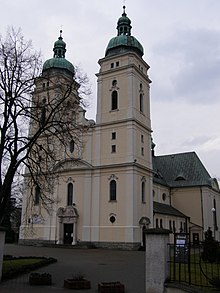Piła is an industrial city of 74,000 people (2017) in the northern part of the Wielkopolskie province in Poland. The city is located on the Gwda river and is famous for its green areas, parks and dense forests nearby.
Understand
[edit]
It is an important road and railway hub, located at the intersection of two main lines: Poznań–Szczecin and Bydgoszcz–Krzyż Wielkopolski.
The history of the town dates back to the 15th century. The Second World War hit the town extremely hard with almost 90% of the town centre destroyed. After this, the town was rebuilt from scratch, which results in a very low number of historical evidence visible to those who visit the town.
Get in
[edit]By plane
[edit]The nearest airports with scheduled passenger service are in Poznań (105 km) and Bydgoszcz (100 km).
By train
[edit]There is one railway station in the city - Piła Główna - and three passenger stops - Piła Podlasie on line 203 and Piła Kalina and Piła Leszków (closed since 2008) on line 354.
By bicycle
[edit]Several transit tourist bicycle routes pass through the city:
- the European Bicycle Route Euro Route R1, leading from the English Channel in France, through Belgium, the Netherlands and Germany to St. Petersburg in Russia, and through Piła
- Transwielkopolska Trasa Rowerowa - a section of the north, approx. 200 km long, connecting many sightseeing, architectural and natural curiosities between Poznań and Okonek;
- A ring of tourist bicycle routes - creating a 38-km-long yellow bicycle route around Piła, with the starting point at ul. Wałecka and along Kamienna and Wypoczynkowa Streets to Kotuń, and then to Motylewo, along Przemysłowa, Walki Młodych and ul. Na Leszków - to the end point at ul. Wawelska
By car
[edit]National and provincial roads running through Piła:
- National road No. 10 Szczecin - Stargard - Piła - Bydgoszcz - Toruń - Płońsk 7
- National road No. 11 Kołobrzeg - Koszalin - Szczecinek - Piła - Poznań - Ostrów - Kępno - Lubliniec - Bytom
- Provincial road No. 179 Piła - Rusinowo 22
- Provincial road No. 180 Piła - Trzcianka - Wieleń
- Provincial road No. 188 Piła - Złotów - Człuchów
Get around
[edit]Miejski Zakład Komunikacji operates 18 bus lines, one of which (Line 50) leaves the administrative borders of the city, going to Ujście and Mirosław. The MZK fleet is mostly low-floor. The Piła City Card is used for bus fares.
PKS Piła operates local bus connections with Chodzież, Czarnków, Wągrowiec, Wyrzysk, Trzcianka, Złotów, and Poznań. The bus station is on Kwiatowa Street, near the Piła Główna train station.
See
[edit]- 1 Piła Army Museum (Pilskie Muzeum Wojskowe), ☏ +48 510551743.

- 2 Holy Family Church. Built in Neo-baroque style, formerly concathedral of the Prałatura Pilska
- 3 St. Anthony's Church. It has the biggest wooden figure of Jesus in Europe, seven metres (23 feet) tall. It was built in 1930.

- Museum of Stanisław Staszic in his former house
- 19th-century building of the former arsenal
- St. Stanislaus Kostka's church, built in Neo-Gothic style
- Two war cemeteries (prisoners from World War I and Polish and Soviet soldiers killed during the battle of Wał Pomorski (Pommerstellung) during World War II); cemeteries are in uptown Piła, in Leszków.
Do
[edit]- 1 Aquapark Piła, ul. Artura Grottgera 4, ☏ +48 672117340.


